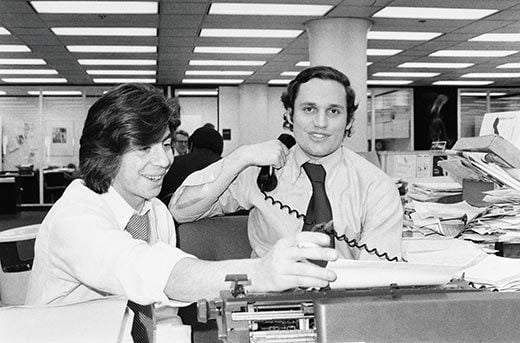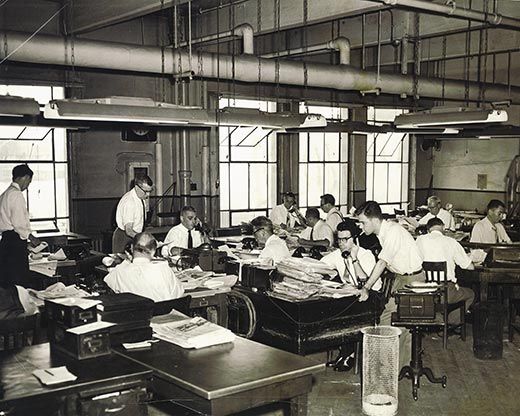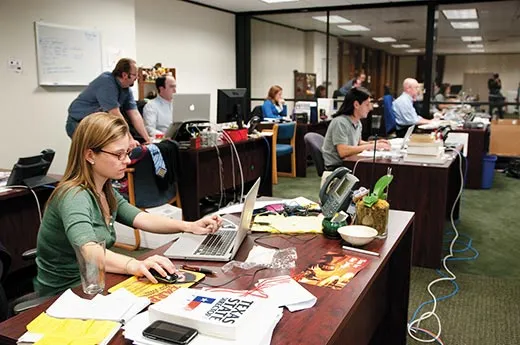The Newsroom Rush of Old
Newsrooms may look different today, but their need for speed never wavers
/https://tf-cmsv2-smithsonianmag-media.s3.amazonaws.com/filer/Indelible-Journal-American-newsroom-631.jpg)
No image brings a tear to the eye of even the crustiest ink-on-paper romantic like a yellowing photograph of the city room of a deceased newspaper. The men in this photograph, circa 1950, are putting out the New York Journal-American, which was born in 1937. The Journal-American was once the city’s most widely read afternoon newspaper—yes, afternoon paper, a once-grand tradition of American journalism that has gone the way of the Linotype machine, the gluepot and the spike onto which editors would stick stories they deemed unworthy of publication.
Its newsroom was typical of the time. The furnishings look as if they had been plucked from a garage sale—scarred wooden desks, manual typewriters perched on rolling stands, hard-backed chairs. The congestion borders on the claustrophobic; note the proximity of one man’s cigarette to another man’s ear. Everyone sits within shouting distance, which was imperative, considering the ambient din—ringing phones, typewriter keys, calls for the copy boys. This was a factory floor. The man who manned the telephones—there were few women on the staff—began his shift by wiping blown-in soot off the desks.
“It wasn’t a place for comfort,” said Richard Piperno in an interview before he died in January at age 88. He started there as a copy boy in 1940 and stayed 26 years. “It was a place for work.”
The photograph captures the city desk, the heart of the newsroom, with its editors facing off at the center and the copy editors arrayed around their horseshoe of a communal desk—the “rim”—to the right. It is not surprising that they are leaning forward, in various states of enterprise. The Journal-American put out five editions a day, plus extras for big stories, from its home on the Lower East Side of Manhattan. In a city with seven daily newspapers, speed was a matter of survival.
Thus news came in by telephone, called in by legmen—reporters who scoured the town for stories. Their calls were routed to one of the city editors, who, depending on the urgency or piquancy of the story (“Gives Up As Killer Of Wife and Finds She’s Not Dead”), would forward the call to a rewrite man—the sort of writer who could adjust his prose to the story at hand. (“When burlesque makes its bow tonight on the Lower East Side, License Commissioner O’Connell will be on hand to watch every wiggle and waggle.”) The rewrite men usually got the bylines; the legmen were widely believed to be functionally illiterate.
Fittingly, the photograph captures the paper’s city editor, Paul Schoenstein—the fellow in the pressed shirt and knotted tie sitting in front of a row of pipes at the back of the newsroom—doing what he did all day: talking on the telephone. Schoenstein was a legend, having won a Pulitzer Prize in 1944 in what became typical Journal-American fashion: when a father called to say that his 2-year-old daughter would die in seven hours if she did not receive penicillin, Schoenstein mobilized his staff to scour the metropolitan area for the then-rare medicine and deliver it to the hospital. They found some in New Jersey. “Journal-American Races Penicillin to Girl.” (She died two months later.)
Given the ferocity of the competition, it was a great time to be a journalist (and a reader). But it didn’t last: the Journal-American died in 1966, a victim, like other afternoon papers, of television news.
And so the newspaper industry entered a new era: for the survivors facing diminishing competition, profits grew fatter and newsrooms grew plusher. Carpeting covered floors, computers supplanted typewriters and no-smoking signs replaced the cuspidors. Reporters sat in cubicles equipped with ergonomically correct chairs. A new generation, college-educated and sexually integrated, lent the business a veneer of professionalism. Old-timers groused.
Now that era is ending. Advertisers have deserted newspapers for the Internet, where readers get their news, and a lot of misinformation, for free. The newsroom is being depopulated by buyouts and layoffs. But a new model is emerging. It isn’t the vast factory floor of the past, but it is still built for speed. A good reporter needs only a smartphone, a laptop and a digital recorder (a trust fund can also come in handy) to set up shop and start breaking news, a nanosecond or two ahead of the competition. Once again, the news beat is a free-for-all. The Journal-American may be gone, but its spirit—irreverent, brash, opinionated, occasionally daring and, above all, competitive—lives on.
Michael Shapiro is the author, most recently, of Bottom of the Ninth.


